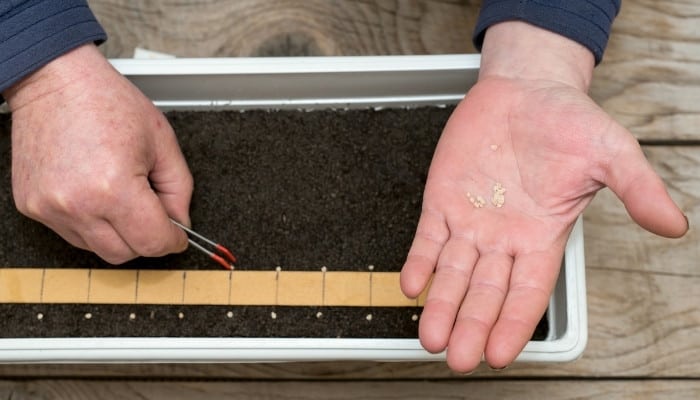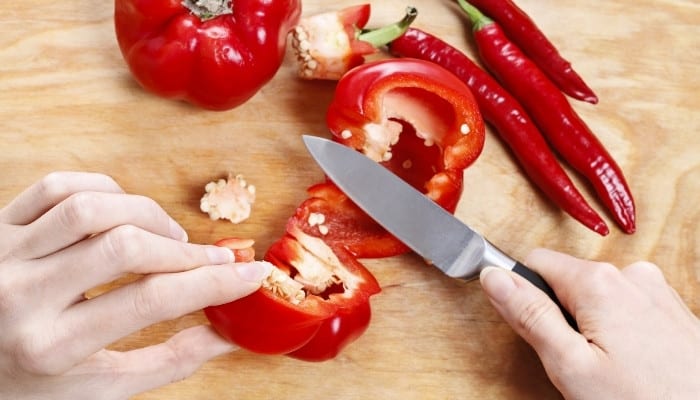Many hobby gardeners find seed saving to be an intriguing activity. However, it is more complex than simply collecting and replanting seeds from a plant the next year.
For most plants, including peppers, there is a drying-and-storing process necessary to ensure the viability of the seeds.
This article will explain everything you need to know to successfully harvest and store your pepper seeds and grow them the following season.
How do you harvest pepper seeds? Harvesting pepper seeds is a fairly easy process. Once the peppers have completely ripened, cut them open, and remove the seeds. After allowing the seeds to dry out for approximately one week, store them in a cool, dry location until you are ready to plant.
By saving pepper seeds each year, you can save money on seed costs. In addition, you can guarantee that you have seeds available for the type of pepper you want to grow.
How To Harvest Pepper Seeds
This seems like a simple process, but each step is vital to ensuring the vitality of the seeds.
1. Select Ripe Peppers From Non-Hybrid Varieties
Hybrid plants are a crossbreed of two different varieties. The seeds they produce tend to have the qualities of one of the parents and not the hybrid.
While you can still collect the seeds, you will not know how the peppers grown from the seeds will look and taste.
For most pepper varieties, you will need to leave the fruit on the plant until it turns orange or red and the skin begins to wrinkle. Riper peppers increase your odds of having more viable seeds to collect.
When choosing which plants to collect seeds from, the decision is all up to your preference. You may want to collect seeds from the most delicious peppers or the plants that produce the highest yield.
2. Remove Seeds From Peppers
Carefully cut open the pepper and remove all the seeds inside. The seeds should be white or cream. Discard any seeds that are damaged or rotten.
For hot peppers, use gloves when handling the peppers and removing the seeds. If you are especially sensitive to the heat, it can help to also wear goggles during this process.
3. Allow Seeds To Dry Completely
Spread out the seeds on paper towels or newspaper, and place them in a sunny, warm location. Every couple of days, turn the seeds so they can evenly dry.
It takes approximately one week for the seeds to dry out completely.
4. Store in a Cool, Dry Location
Once the seeds are dry, place them in airtight plastic bags. All pepper seeds look similar, so make sure you label the bag with the variety of pepper and the date the seeds were collected.
Place the bags of seeds in a sealed container (like a plastic Tupperware container) and place the container in the refrigerator. The seeds should be kept between 35 – 50℉.
How Long Do Pepper Seeds Last?
If the pepper seeds are properly stored, they can last for many years. However, the germination rate will decrease as time goes on.
Did you know that peppers are one of the easiest crops to grow hydroponically? It’s true, and the process is fairly simple. This article provides all the basics you need to know to get started.
How Can You Tell If Pepper Seeds Are Good?
Pepper seeds should be dry and free from damage. They should be a color between white and light brown. A bad smell, dark color, and mold are all signs of rotten seeds.
What Color Should Pepper Seeds Be?
Pepper seeds should be white or cream in color. Some pepper seeds turn light brown during the drying process, and this does not affect their ability to germinate.
Do Brown Pepper Seeds Germinate?
Seeds that turned light brown during the drying process will still germinate. Seeds that are dark brown, especially if they have a soft texture, are most likely rotten and will not germinate.
Germinating Pepper Seeds

1. Begin 8 Weeks Before Planting
Seeds should be started 8 weeks before you plan to plant them outdoors. Older seeds and very hot pepper varieties will take longer to germinate and should be given 10-12 weeks indoors.
2. Prepare Your Setup
Use a seed starting tray that has multiple cells and a clear lid. This seed starting kit is ideal. It comes with five base trays for sturdiness, five 40-cell seed trays, and five domed lids to retain humidity.
Organic peat pots for seed starting are another option.
With these, plant roots are not disturbed when it comes time to plant them. You just cut the individual cells apart, and plant the seedlings, peat pot and all, into garden soil.
The peat pots will help retain soil moisture until they eventually decompose into the surrounding soil.
You’ll also need a seed starting mixture (I use this one), which is different from the traditional potting soil.
Label your seed trays before planting the seeds, because the young pepper plants all look similar.
3. Place Several Seeds in Each Cell
Germination is not 100% guaranteed, even with healthy seeds that have been stored properly. Place multiple seeds in each cell to increase your chance of producing a pepper plant.
Use tweezers to plant one seed at a time, and press each seed 1/4 inch into the substrate using a pen or pencil.
4. Add Water
Use a spray bottle to generously mist the top of the soil. Make sure that each seed has been moistened and covered lightly with soil.
5. Place Tray in a Warm Location
Place the seed starting tray (with the clear lid on top) in a warm location. The ideal temperature for pepper seed germination is 80-90℉.
You can use a heat mat (like this one with a convenient digital thermostat) or lamp to maintain the necessary temperature.
6. Maintain Moisture
Pepper seeds need constant moisture to germinate. If the soil begins to dry out, mist it lightly. Once a day, lift the lid on the seed starting tray to allow fresh air to circulate.
7. Wait 2 Weeks
It usually takes 1-2 weeks for the seeds to begin sprouting. Hotter pepper varieties and older seeds may take up to 4 weeks to germinate.
8. Move Under Grow Light
Once the seeds have begun sprouting, place the tray near a bright window or under a grow light, and keep the area warm.
The seedlings should remain here until they can be planted outside (after the last frost).
If you don’t yet have a grow light, I recommend this one for seedlings. It features three arms to allow for multiple seedling trays, has five levels of brightness, and three timing options.
No growing season is complete without a few problems arising. Click here to learn the most common problems encountered when growing peppers and how to avoid and resolve them.
Related Questions:
What’s the Fastest Way To Germinate Pepper Seeds?
The fastest way to germinate pepper seeds is to maintain a temperature of 80-90℉ and keep the seeds moist until they sprout.
Soaking seeds overnight in room-temperature water before planting can speed germination as well.
Can You Plant Peppers in the Same Place Every Year?
It is better to rotate the location of plants each year because different plants require different amounts of nutrients.
If you are going to plant peppers in the same place each year, make sure you fortify your soil with compost, manure, and organic fertilizer before the growing season.
Conclusion
Pepper plants are pretty easy going once they get started and aren’t difficult to start from seed.
Now that you have all the information you need to save your pepper seeds at the end of each season, you can continue to grow for your favorite and best-producing varieties for years to come.

